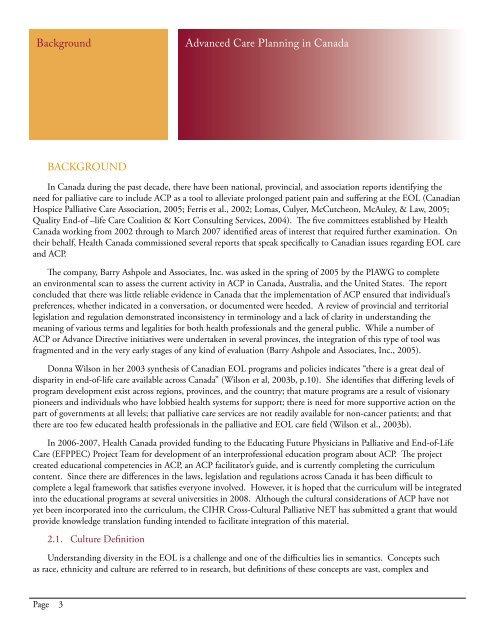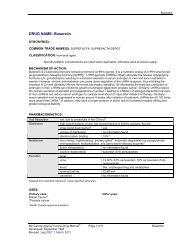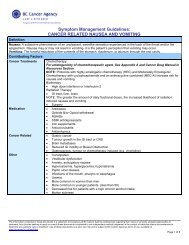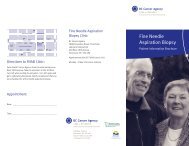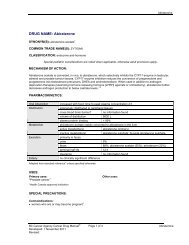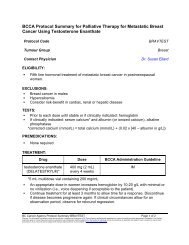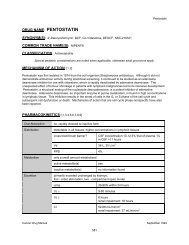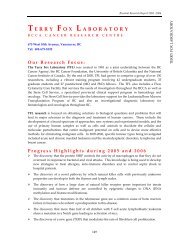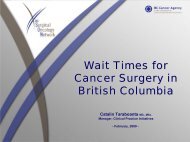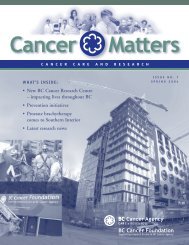Cross-Cultural Considerations in Promoting Advance Care Planning ...
Cross-Cultural Considerations in Promoting Advance Care Planning ...
Cross-Cultural Considerations in Promoting Advance Care Planning ...
Create successful ePaper yourself
Turn your PDF publications into a flip-book with our unique Google optimized e-Paper software.
Background<br />
<strong>Advance</strong>d <strong>Care</strong> Plann<strong>in</strong>g <strong>in</strong> Canada<br />
BACKGROUND<br />
In Canada dur<strong>in</strong>g the past decade, there have been national, prov<strong>in</strong>cial, and association reports identify<strong>in</strong>g the<br />
need for palliative care to <strong>in</strong>clude ACP as a tool to alleviate prolonged patient pa<strong>in</strong> and suffer<strong>in</strong>g at the EOL (Canadian<br />
Hospice Palliative <strong>Care</strong> Association, 2005; Ferris et al., 2002; Lomas, Culyer, McCutcheon, McAuley, & Law, 2005;<br />
Quality End-of –life <strong>Care</strong> Coalition & Kort Consult<strong>in</strong>g Services, 2004). The five committees established by Health<br />
Canada work<strong>in</strong>g from 2002 through to March 2007 identified areas of <strong>in</strong>terest that required further exam<strong>in</strong>ation. On<br />
their behalf, Health Canada commissioned several reports that speak specifically to Canadian issues regard<strong>in</strong>g EOL care<br />
and ACP.<br />
The company, Barry Ashpole and Associates, Inc. was asked <strong>in</strong> the spr<strong>in</strong>g of 2005 by the PIAWG to complete<br />
an environmental scan to assess the current activity <strong>in</strong> ACP <strong>in</strong> Canada, Australia, and the United States. The report<br />
concluded that there was little reliable evidence <strong>in</strong> Canada that the implementation of ACP ensured that <strong>in</strong>dividual’s<br />
preferences, whether <strong>in</strong>dicated <strong>in</strong> a conversation, or documented were heeded. A review of prov<strong>in</strong>cial and territorial<br />
legislation and regulation demonstrated <strong>in</strong>consistency <strong>in</strong> term<strong>in</strong>ology and a lack of clarity <strong>in</strong> understand<strong>in</strong>g the<br />
mean<strong>in</strong>g of various terms and legalities for both health professionals and the general public. While a number of<br />
ACP or <strong>Advance</strong> Directive <strong>in</strong>itiatives were undertaken <strong>in</strong> several prov<strong>in</strong>ces, the <strong>in</strong>tegration of this type of tool was<br />
fragmented and <strong>in</strong> the very early stages of any k<strong>in</strong>d of evaluation (Barry Ashpole and Associates, Inc., 2005).<br />
Donna Wilson <strong>in</strong> her 2003 synthesis of Canadian EOL programs and policies <strong>in</strong>dicates “there is a great deal of<br />
disparity <strong>in</strong> end-of-life care available across Canada” (Wilson et al, 2003b, p.10). She identifies that differ<strong>in</strong>g levels of<br />
program development exist across regions, prov<strong>in</strong>ces, and the country; that mature programs are a result of visionary<br />
pioneers and <strong>in</strong>dividuals who have lobbied health systems for support; there is need for more supportive action on the<br />
part of governments at all levels; that palliative care services are not readily available for non-cancer patients; and that<br />
there are too few educated health professionals <strong>in</strong> the palliative and EOL care field (Wilson et al., 2003b).<br />
In 2006-2007, Health Canada provided fund<strong>in</strong>g to the Educat<strong>in</strong>g Future Physicians <strong>in</strong> Palliative and End-of-Life<br />
<strong>Care</strong> (EFPPEC) Project Team for development of an <strong>in</strong>terprofessional education program about ACP. The project<br />
created educational competencies <strong>in</strong> ACP, an ACP facilitator’s guide, and is currently complet<strong>in</strong>g the curriculum<br />
content. S<strong>in</strong>ce there are differences <strong>in</strong> the laws, legislation and regulations across Canada it has been difficult to<br />
complete a legal framework that satisfies everyone <strong>in</strong>volved. However, it is hoped that the curriculum will be <strong>in</strong>tegrated<br />
<strong>in</strong>to the educational programs at several universities <strong>in</strong> 2008. Although the cultural considerations of ACP have not<br />
yet been <strong>in</strong>corporated <strong>in</strong>to the curriculum, the CIHR <strong>Cross</strong>-<strong>Cultural</strong> Palliative NET has submitted a grant that would<br />
provide knowledge translation fund<strong>in</strong>g <strong>in</strong>tended to facilitate <strong>in</strong>tegration of this material.<br />
2.1. Culture Def<strong>in</strong>ition<br />
Understand<strong>in</strong>g diversity <strong>in</strong> the EOL is a challenge and one of the difficulties lies <strong>in</strong> semantics. Concepts such<br />
as race, ethnicity and culture are referred to <strong>in</strong> research, but def<strong>in</strong>itions of these concepts are vast, complex and<br />
Page


